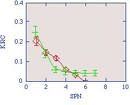|

|
Misha Tsodyks
Models of Brain Functions
|
My research is in the field of
computer modeling in neuroscience. Computer models of brain functions are rapidly
becoming important as the amount of experimental data available grows steadily,
and computer power and theoretical ideas are being developed.
The goals of computational
models are very diverse, ranging from the understanding of consciousness to
the properties of individual neurons. My main interest lies in the properties
of large-scale neuronal networks, responsible for such brain functions as memory,
processing of visual information and spatial navigation. Understanding these
complex functions requires a multidisciplinary approach, comprising techniques
and ideas of biology, physics and computer science. Several theoretical ideas
proposed recently regarding the neuronal mechanisms of associative memory were
borrowed from statistical physics. According to these ideas, the cooperative
dynamics of large neuronal populations are the correlate of information processing.
In my work I apply this line of research to developing biologically plausible
models of information processing and memory.
My most rewarding work by now in this direction
was performed in collaboration with Prof. D. Amit, while I was in the Hebrew
University. We have constructed a neural network model of visual memory, which
captured the results of the delayed memory experiments on monkeys, performed
in the lab of Miyashita in Tokyo. The model explained how the neuronal representations
of the pictures in the monkey's visual cortex became correlated dependingon
the order in which they were learned.
It is conceivable that the progress in computational
neuroscience will accelerate due to the development of new experimental technique,
such as optical imaging of the brain, and multiunit electrical recordings,
which will enable the activity of large populations of neurons to be followed
simultaneously. The data obtained with these modern techniques allows a degree
of comparison with modeling results that so far was not possible. One of my
ongoing projects in the lab of B. McNaughton in Arizona, involves the modeling
of place coding in the rodent hippocampus, and relating it to recordings from
more than 100 neurons simultaneously. As a result of this collaboration, the
influence of cooperative neuronal dynamics on the formation of place specificity
of the hippocampal neurons was found.
I started my scientific career as a Ph.D. student
in the Landau Institute for Theoretical Physics in Moscow. After spending two
years in the Institute of Neurophysiology in Moscow, I moved to the Hebrew
University, where I stayed for 3 years in the Physics Department. For the next
one and a half years I was in the Computational Neurobiology Lab in the Salk
Institute in San Diego, and I recently joined the Weizmann Institute.
Griniasty, M., M.Tsodyks, D.Amit
(1993): Conversion of temporal correlations between stimuli to spatial correlations
between attractors, Neural Computations, 5:1-17.
Tsodyks, M., I.Mit'kov,
H.Sompolinsky (1993): Pattern of synchrony in inhomogeneous networks of oscillators
with pulse interactions. Phys. Rev. Lett., 71:1280-1283.
Amit, D., N. Brunel,
M. Tsodyks (1994): Correlations of cortical Hebbian reverberations: experiment
versus theory, J. Neuroscience, 14:6435-6445.
Tsodyks, M., T. Sejnowski (1995): Rapid switching
in balanced cortical network models, network, 6:111-124.
Tsodyks, M., T.
Sejnowski (1995): Associative memory and hippocampal place cells, Int. Journal
of Neural Systems, in press.
Tel: (972)-8-9342157
Fax: (972)-8-9344140
e-mail: bnmisha@wicc.weizmann.ac.il
Misha Tsodyks home page

Experimental and modeling results of delayed matching to sample
memory task. The monkey had to learn a set of computer-generated pictures presented
in a fixed order. Neuronal representations formed in the monkey's visual cortex
were found to be correlated according to the order in which the pictures were
presented. The correlation coefficient is plotted vs separation in the training
sequence. Symbols are average over cell sample. , Experiment; , Model.
Experimental data are from Fig. 3c of Miyashita (1988): Neuronal correlate
of visual associative long-termmemory in the primate temporal cortex, Nature
331:68.
This site was
developed by Chaipi Wijnbergen
using Accent Multilingual Publisher on 5/5/96
For more information send mail to Ariela
Sharfi

